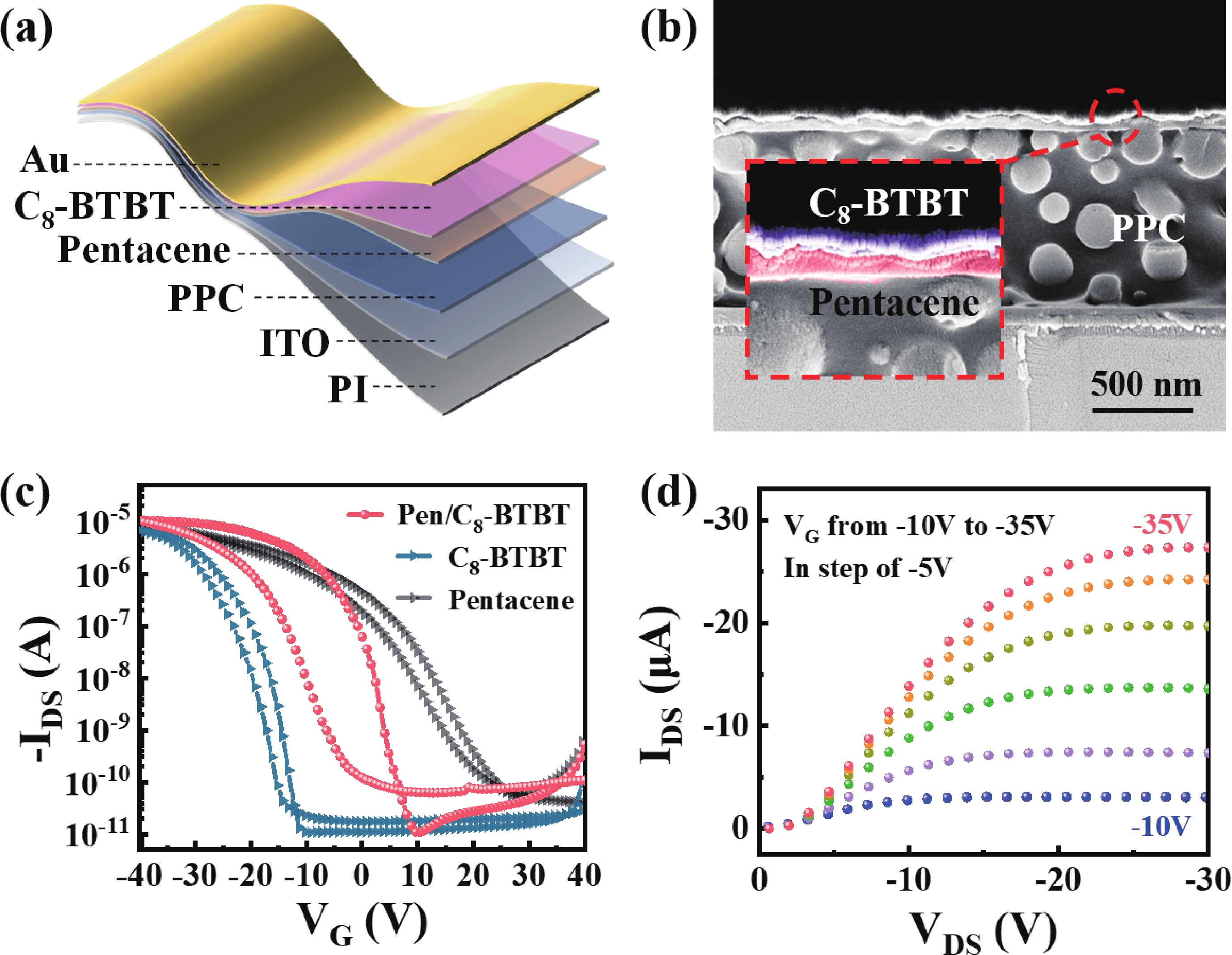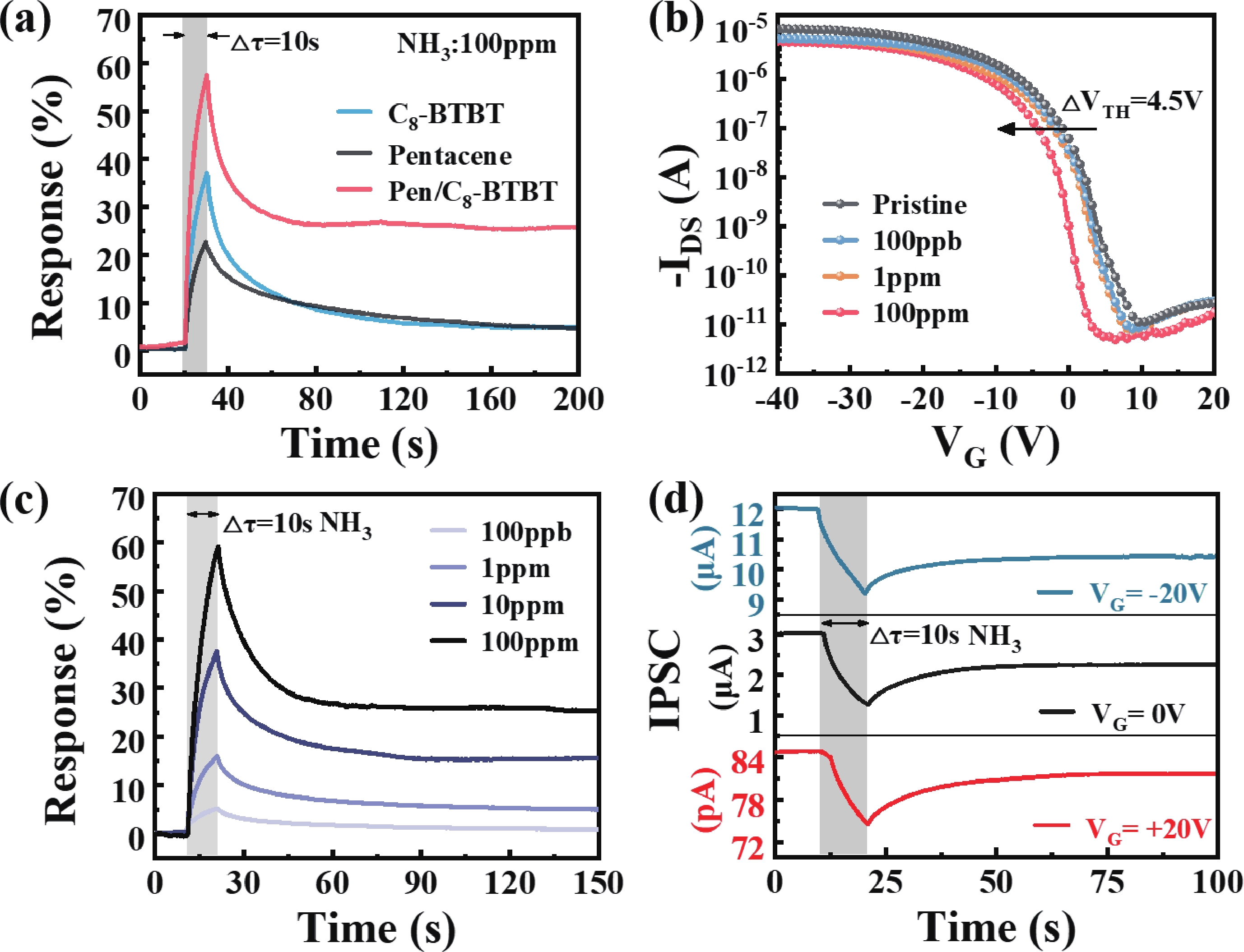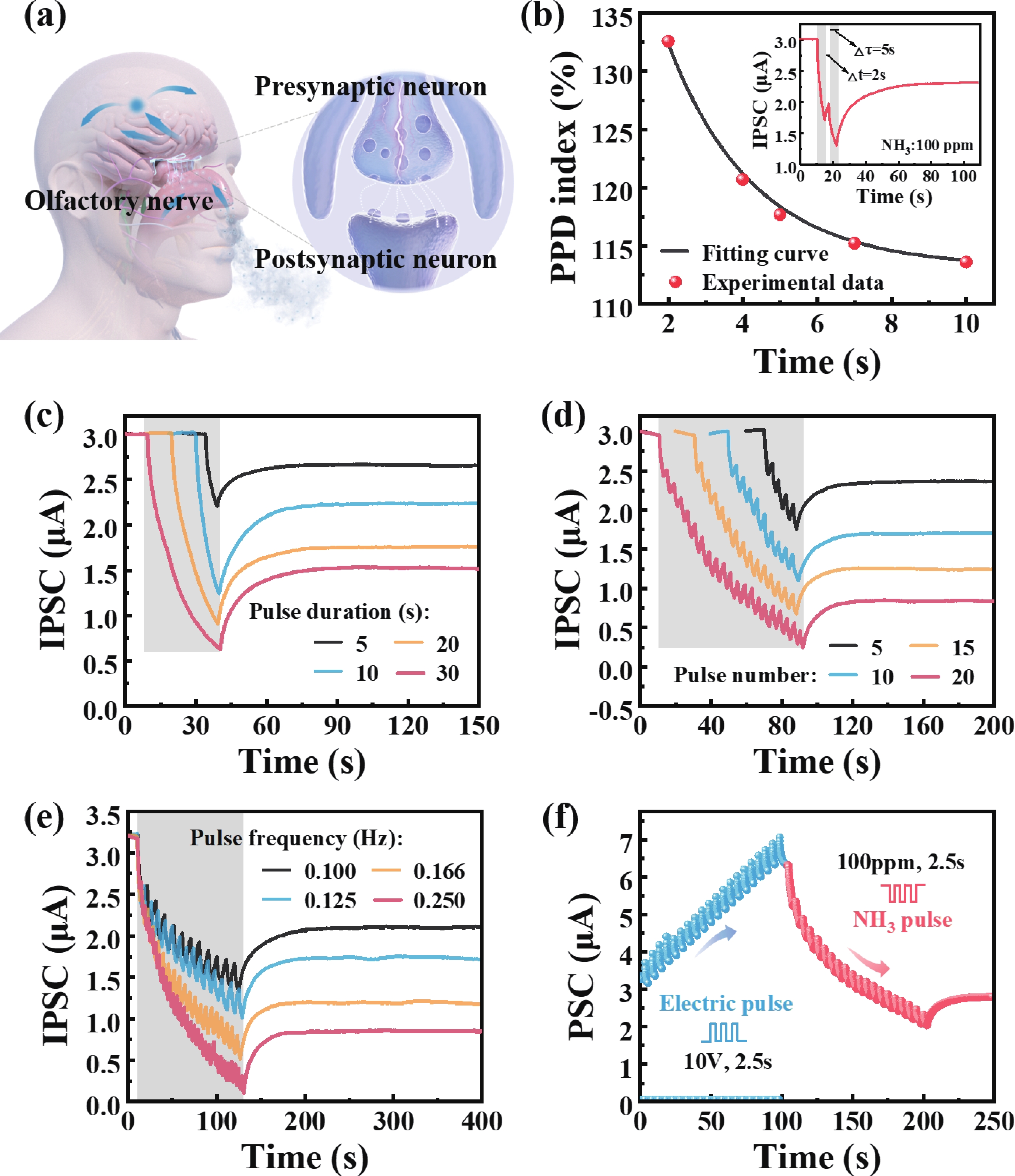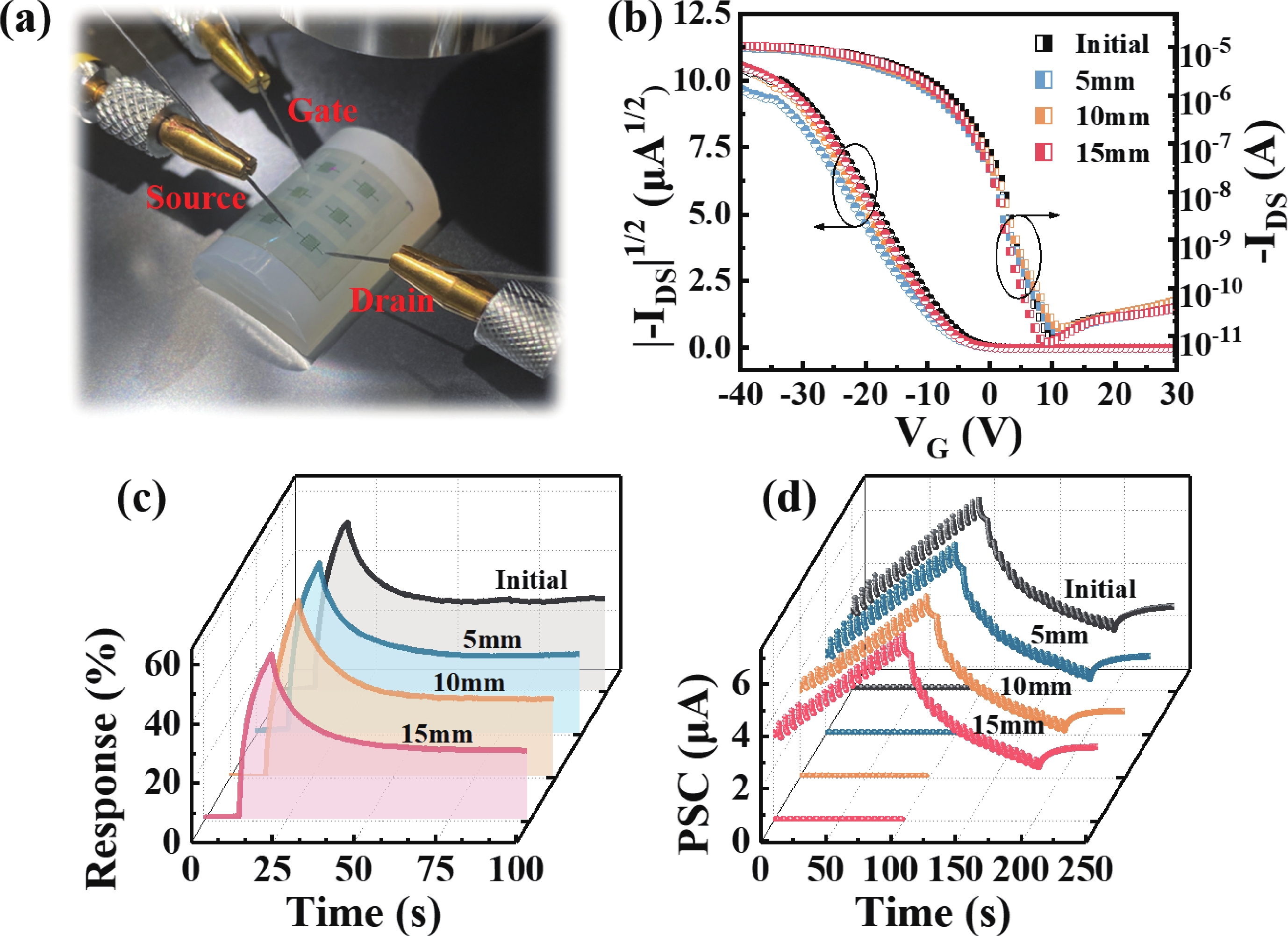| Citation: |
Tianyang Feng, Jialin Meng, Hang Xu, Yafen Yang, Tianyu Wang, Hao Zhu, Qingqing Sun, David Wei Zhang, Lin Chen. Flexible biomimetic olfactory neurons based on organic heterojunction[J]. Journal of Semiconductors, 2024, 45(12): 122302. doi: 10.1088/1674-4926/24090003
****
T Y Feng, J L Meng, H Xu, Y F Yang, T Y Wang, H Zhu, Q Q Sun, D W Zhang, and L Chen, Flexible biomimetic olfactory neurons based on organic heterojunction[J]. J. Semicond., 2024, 45(12), 122302 doi: 10.1088/1674-4926/24090003
|
Flexible biomimetic olfactory neurons based on organic heterojunction
DOI: 10.1088/1674-4926/24090003
More Information
-
Abstract
Simulating the human olfactory nervous system is one of the key issues in the field of neuromorphic computing. Olfactory neurons interact with gas molecules, transmitting and storing odor information to the olfactory center of the brain. In order to emulate the complex functionalities of olfactory neurons, this study presents a flexible olfactory synapse transistor (OST) based on pentacene/C8-BTBT organic heterojunction. By modulating the interface between the energy bands of the organic semiconductor layers, this device demonstrates high sensitivity (ppb level) and memory function for NH3 sensing. Typical synaptic behaviors triggered by NH3 pulses have been successfully demonstrated, such as inhibitory postsynaptic currents (IPSC), paired-pulse depression (PPD), long-term potentiation/depression (LTP/LTD), and transition from short-term depression (STD) to long-term depression (LTD). Furthermore, this device maintains stable olfactory synaptic functions even under different bending conditions, which can present new insights and possibilities for flexible synaptic systems and bio-inspired electronic products. -
References
[1] Zhao Q L, Ma S W, Zhang H K, et al. Olfactory-inspired neuromorphic artificial respiratory perception system with graphene oxide humidity sensor and organic electrochemical transistor. Carbon, 2024, 218, 118765 doi: 10.1016/j.carbon.2023.118765[2] Duan G X, Huang S M, Feng Z H, et al. Three-terminal artificial olfactory sensors based on emerging materials: Mechanism and application. Adv Funct Mater, 2023, 33, 202209969 doi: 10.1002/adfm.202209969[3] Wasilewski T, Brito N F, Szulczynski B, et al. Olfactory receptor-based biosensors as potential future tools in medical diagnosis. Trac Trends Anal Chem, 2022, 150, 116599 doi: 10.1016/j.trac.2022.116599[4] Deng H C, Nakamoto T. Odor biosensors based on cell expressing olfactory receptor: Recent advances. Anal Sens, 2024, 4, e202400006 doi: 10.1002/anse.202400006[5] Yoshii T, Takayama I, Fukutani Y, et al. Development of an odorant sensor with a cell-free synthesized olfactory receptor and a graphene field-effect transistor. Anal Sci, 2022, 38, 241 doi: 10.1007/s44211-022-00073-y[6] Sousa T A S L, Almeida N B F, Santos F A, et al. Ultrafast and highly sensitive detection of SARS-Cov-2 spike protein by field-effect transistor graphene-based biosensors. Nanotechnology, 2024, 35, 4210.1088/1361 doi: 10.1088/1361-6528/ad67e8[7] Li P Z, Zhang M Z, Zhou Q L, et al. Reconfigurable optoelectronic transistors for multimodal recognition. Nat Commun, 2024, 15, 3257 doi: 10.1038/s41467-024-47580-2[8] Wang B R, Li H B, Tan H T, et al. Gate-modulated high-response field-effect transistor-type gas sensor based on the MoS2/metal-organic framework heterostructure. ACS Appl Mater Interfaces, 2022, 14, 42356 doi: 10.1021/acsami.2c11359[9] Harikesh P C, Tu D Y, Fabiano S. Organic electrochemical neurons for neuromorphic perception. Nat Electron, 2024, 7, 525 doi: 10.1038/s41928-024-01200-5[10] Xia J N, Gao C S, Peng C Y, et al. Multidimensional deep ultraviolet (DUV) synapses based on organic/perovskite semiconductor heterojunction transistors for antispoofing facial recognition systems. Nano Lett, 2024, 24, 6673 doi: 10.1021/acs.nanolett.4c01356[11] Shi X F, Xu Y C, Liu W R, et al. Organic heterojunction phototransistors with Bi-directional photoresponse for vision biomimetics. Adv Funct Mater, 2024, 34, 2401534 doi: 10.1002/adfm.202401534[12] Chen Z, Meng C L, Wang X L, et al. Ultrasensitive DNA origami plasmon sensor for accurate detection in circulating tumor dnas. Laser Photon Rev, 2024, 18, 2400035 doi: 10.1002/lpor.202400035[13] Chen Z, Li J F, Li T Z, et al. A CRISPR/Cas12a-empowered surface plasmon resonance platform for rapid and specific diagnosis of the Omicron variant of SARS-CoV-2. Natl Sci Rev, 2022, 9, nwac104 doi: 10.1093/nsr/nwac104[14] Gao Z Y, Chen S, Li R, et al. An artificial olfactory system with sensing, memory and self-protection capabilities. Nano Energy, 2021, 86, 106078 doi: 10.1016/j.nanoen.2021.106078[15] Chu Y L, Tan H T, Zhao C Y, et al. Power-efficient gas-sensing and synaptic diodes based on lateral pentacene/a-IGZO pn junctions. ACS Appl Mater Interfaces, 2022, 14, 9368 doi: 10.1021/acsami.1c19771[16] Li J, Fu W H, Lei Y X, et al. Oxygen-vacancy-induced synaptic plasticity in an electrospun ingdo nanofiber transistor for a gas sensory system with a learning function. ACS Appl Mater Interfaces, 2022, 14, 8587 doi: 10.1021/acsami.1c23390[17] Chouhdry H H, Lee D H, Bag A, et al. A flexible artificial chemosensory neuronal synapse based on chemoreceptive ionogel-gated electrochemical transistor. Nat Commun, 2023, 14, 821 doi: 10.1038/s41467-023-36480-6[18] Song H W, Moon D, Won Y, et al. A pattern recognition artificial olfactory system based on human olfactory receptors and organic synaptic devices. Sci Adv, 2024, 10, eadl2882 doi: 10.1126/sciadv.adl2882[19] Zhang C C, Chen P L, Hu W P. Organic field-effect transistor-based gas sensors. Chem Soc Rev, 2015, 44, 2087 doi: 10.1039/C4CS00326H[20] Cavallari M R, Pastrana L M, Sosa C D F, et al. Organic thin-film transistors as gas sensors: A review. Materials, 2021, 14, 3 doi: 10.3390/ma14010003[21] Qian C, Sun J, Kong L A, et al. Multilevel nonvolatile organic photomemory based on vanadyl-phthalocyanine/para-sexiphenyl heterojunctions. ACS Photonics, 2017, 4, 2573 doi: 10.1021/acsphotonics.7b00898[22] Qian C, Oh S, Choi Y, et al. Solar-stimulated optoelectronic synapse based on organic heterojunction with linearly potentiated synaptic weight for neuromorphic computing. Nano Energy, 2019, 66, 106078 doi: 10.1016/j.nanoen.2019.104095[23] Sharma S, Kar D, Khanikar P D, et al. Hybrid MoSe2/P3HT transistor for real-time ammonia sensing in biofluids. ACS Appl Mater Interfaces, 2024, 16, 30648 doi: 10.1021/acsami.4c02352[24] Tran V V, Jeong G, Kim K S, et al. Facile strategy for modulating the nanoporous structure of ultrathin π-Conjugated polymer films for high-performance gas sensors. ACS Sens, 2022, 7, 175 doi: 10.1021/acssensors.1c01942[25] Lee B H, Kim S, Lee S Y. Ammonia gas sensing properties of 6, 13-bis(tri-isopropylsilyethynyl) pentacene based field-effect transistor. Trans Electr Electron Mater, 2022, 23, 182 doi: 10.1007/s42341-022-00381-0[26] Chen L, Hu Y Z, Huang H X, et al. Femtosecond laser-assisted device engineering: Toward organic field-effect transistor-based high-performance gas sensors. ACS Appl Mater Interfaces, 2022, 14, 32299 doi: 10.1021/acsami.2c06904[27] Aarya S, Kumar Y, Chahota R K. Recent advances in materials, parameters, performance and technology in ammonia sensors: A review. J Inorg Organomet Polym Mater, 2020, 30, 269 doi: 10.1007/s10904-019-01208-x[28] Wang S J, Chen X, Zhao C, et al. An organic electrochemical transistor for multi-modal sensing, memory and processing. Nat Electron, 2023, 6, 281 doi: 10.1038/s41928-023-00950-y[29] Cui N, Tan Q X, Ren H, et al. A photolithographic stretchable transparent electrode for an all-solution-processed fully transparent conformal organic transistor array. J Mater Chem C, 2019, 7, 5385 doi: 10.1039/C9TC01182J[30] Liu W R, Chen W Z, Jin C X, et al. Organic optoelectrical synaptic transistors for color information processing. Appl Phys Lett, 2023, 123, 7 doi: 10.1063/5.0173413[31] Qian Y Z, Li J Y, Li W, et al. PBDB-T/pentacene-based organic optoelectronic synaptic transistor with adjustable critical flicker fusion frequency for dynamic vision. ACS Appl Mater Interfaces, 2024, 16, 20843 doi: 10.1021/acsami.3c19165[32] Ghawanmeh A A, A Tanash S, Al-Rawashdeh N A F, et al. The recent progress on nanomaterial-based chemosensors for diagnosis of human exhaled breath: A review. J Mater Sci, 2024, 59, 8573 doi: 10.1007/s10853-024-09680-8[33] Rullyani C, Sung C F, Lin H C, et al. Flexible organic thin film transistors incorporating a biodegradable CO2-based polymer as the substrate and dielectric material. Sci Rep, 2018, 8, 8146 doi: 10.1038/s41598-018-26585-0[34] Yu T P, Hou S Y, Liu Z L, et al. Enhanced performance of organic field-effect transistor with bi-functional N-type organic semiconductor layer. Adv Electron Mater, 2024, 10, 2300651 doi: 10.1002/aelm.202300651[35] Kim Y, Lee D, Nguyen K V, et al. Optimization of gas-sensing properties in poly(triarylamine) field-effect transistors by device and interface engineering. Polymers, 2023, 15, 3463 doi: 10.3390/polym15163463[36] Li Q X, Wang T Y, Wang X L, et al. Flexible organic field-effect transistor arrays for wearable neuromorphic device applications. Nanoscale, 2020, 12, 23150 doi: 10.1039/D0NR06478E[37] Meng J L, Wang T Y, Chen L, et al. Energy-efficient flexible photoelectric device with 2D/0D hybrid structure for bio-inspired artificial heterosynapse application. Nano Energy, 2021, 83, 105815 doi: 10.1016/j.nanoen.2021.105815[38] Deng Y P, Zhao M Y, Ma Y, et al. A flexible and biomimetic olfactory synapse with gasotransmitter-mediated plasticity. Adv Funct Mater, 2023, 33, 2214139 doi: 10.1002/adfm.202214139[39] Sokolov Andrey S, Abbas H, Abbas Y, et al. Towards engineering in memristors for emerging memory and neuromorphic computing: A review. J Semicond, 2021, 42, 013101 doi: 10.1088/1674-4926/42/1/013101[40] Hu X M, Meng J L, Li Q X, et al. Flexible organic optoelectronic devices for neuromorphic computing. IEEE Electron Device Lett, 2023, 44, 1100 doi: 10.1109/LED.2023.3274825 -
Proportional views





 Tianyang Feng is currently a Ph.D student at the School of Microelectronics, Fudan University under the supervision of Prof. Lin Chen. His research interests are organic transistors and their applications in the field of neuromorphic computing.
Tianyang Feng is currently a Ph.D student at the School of Microelectronics, Fudan University under the supervision of Prof. Lin Chen. His research interests are organic transistors and their applications in the field of neuromorphic computing. Jialin Meng received her Ph.D degree in microelectronics and solid-state electronics from Fudan University, Shanghai, China in 2022. She is currently a Postdoctor in the School of Microelectronics, Fudan University. Her research focuses on the optoelectronic neuromorphic devices, in-sensor computing, and flexible electronics.
Jialin Meng received her Ph.D degree in microelectronics and solid-state electronics from Fudan University, Shanghai, China in 2022. She is currently a Postdoctor in the School of Microelectronics, Fudan University. Her research focuses on the optoelectronic neuromorphic devices, in-sensor computing, and flexible electronics. Lin Chen is currently a professor at the State Key Laboratory of ASIC and System, School of Microelectronics, Fudan University, China. He received his Ph.D (2012) degree in Microelectronics from Fudan University, China. His research interests include non-volatile memory and applications, organic memory, low-power neuromorphic computing system and in-memory computing devices.
Lin Chen is currently a professor at the State Key Laboratory of ASIC and System, School of Microelectronics, Fudan University, China. He received his Ph.D (2012) degree in Microelectronics from Fudan University, China. His research interests include non-volatile memory and applications, organic memory, low-power neuromorphic computing system and in-memory computing devices.
 DownLoad:
DownLoad:

















